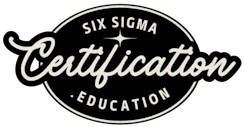Six Sigma Certification &
Learning Solutions
Six Sigma Certification Courses Online
What we do
In Demand
Get Certified
Frequently asked questions about Six Sigma
What are the differences between Six Sigma Yellow Belt, Green Belt, and Black Belt in terms of skills and responsibilities?
How much does a Six Sigma Green Belt or Black Belt certification cost from reputable providers?
Can I complete a Six Sigma Green Belt or Black Belt certification fully online?
Do I need to complete a project to get certified as a Green Belt or Black Belt in Six Sigma?
Is Six Sigma certification recognized across industries like healthcare, finance, and manufacturing?
Should I start with Lean Six Sigma or pure Six Sigma? What is the real difference?
Is it worth getting a Six Sigma certification early in my career?
What benefits do individuals and companies get from Six Sigma certification?
What is DMAIC and how is it applied during Six Sigma training?
What are common Six Sigma exam question types and how should I prepare for them?
Six Sigma Certification Education (SSCE) vs Competitors
While competitors often rely on brand recognition or inflated price tags, SSCE has positioned itself as the smarter choice for working professionals who want real value. The question isn't just "where can I get certified," but "where will my time and money deliver the highest return?" That's where SSCE stands apart.
Why Choose SSCE Over Competitors
1. Affordable Pricing Without Compromising Quality
Many competitors charge thousands of dollars for certification programs. SSCE provides the same level of rigorous training and professional recognition at a fraction of the cost, making Six Sigma accessible to anyone serious about career advancement.
2. Flexible, Self-Paced Learning
Unlike traditional classroom-based competitors, SSCE is built around flexibility. You can study on your own schedule, complete modules when it's convenient, and take your certification exam as soon as you're ready - no rigid start dates or deadlines.
3. Streamlined Certification Pathways
Competitors often require you to complete multiple lower-level belts before advancing. SSCE allows learners to enroll directly in the certification level that fits their career goals, saving time and unnecessary expenses.
4. Focused and Practical Training Content
Rather than burying students in theory, SSCE programs emphasize practical application. You'll learn how to solve real-world business problems and deliver measurable improvements-skills employers value immediately.
5. Recognized and Respected Credentials
SSCE certifications are widely recognized by employers across industries. The programs are structured to align with the standards of Six Sigma practice, ensuring graduates hold respected credentials that stand up against any competitor.
6. Comprehensive Support Materials
From exam prep guides to study aids, SSCE equips learners with tools competitors often charge extra for. This additional support ensures you're well prepared to succeed the first time.
7. Career-Focused Outcomes
SSCE was designed not just to teach Six Sigma, but to help professionals earn promotions, transition into leadership roles, and increase their earning potential. Competitors often miss this career-focused approach.
8. Transparent Process and No Hidden Costs
Many certification providers advertise one price but charge extra for exams, materials, or renewals. SSCE provides a clear, all-inclusive path so you know exactly what you're investing in from the start.

